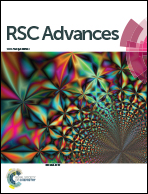Structure- and solvent-triggered influences in the self-assembly of polyoxometalate–steroid conjugates†
Abstract
We report that supramolecular structures formed by polyoxometalate–steroid conjugates in a self-assembly process can be greatly influenced by molecular structures and solution components. Specifically, we deliberately selected three steroids (e.g. cholic acid, dehydrocholic acid, cholesterol) and an organically modified Anderson-type POM cluster to construct conjugates with the molecular structure of steroid–POM–steroid, then carried out careful research on their supramolecular self-assembly in toluene–DMF, CH2Cl2–CH3OH and acetone, respectively. Upon investigation of the TEM and AFM characterizations, we found that the three POM–steroid conjugates displayed unexpectedly different supramolecular structures in the self-assembly process, and only the POM–Chol conjugate could fabricate well-defined fibrous structures in different solutions. Based on the TEM, AFM, FT-IR and XRD characterizations and discussion, a mechanism of the hierarchical self-assembly process of the POM–cholesterol conjugate was also proposed. Moreover, we explained on a molecular level why the morphologies of the POM–Chol conjugate in different solvents were better than those of the POM–Ca conjugate and POM–Dhca conjugate.


 Please wait while we load your content...
Please wait while we load your content...